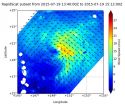Study: The Angelina Jolie Effect on breast cancer screening
2015-07-20
(Press-News.org) Angelina Jolie received widespread media attention in 2013 when she told the public that she'd tested positive for BRCA1, a gene associated with an increased risk of breast and ovarian cancers, and subsequently had a double mastectomy. Now research shows that this publicity did influence some women's intentions to seek out similar genetic testing.
"We put a questionnaire online within three days of Jolie's announcement, to see if the announcement influenced anyone's intention to get genetic testing," says Kami Kosenko, an associate professor of communication at North Carolina State University and lead author of a paper on the work. "We also wanted to see if there were any variables, such as whether people felt they identified with Jolie, that were associated with people who were influenced by Jolie's announcement."
Three hundred and fifty-six people from across the United States completed the questionnaire, of which 295 were aware of Jolie's announcement.
Of the 229 female study participants, researchers found that 30 percent intended to get tested to see if they carried the BRCA1 gene, with 23 percent saying they would probably get tested and 7 percent saying they would definitely get tested.
"Women who identified more strongly with Jolie were more likely to intend to get the genetic testing regardless of whether they had a family history of cancer than women who did have a family history of cancer but did not identify with Jolie," Kosenko says. "The same was true of women who felt they had some sort of parasocial relationship with Jolie, meaning they viewed her as a friend. This means that Jolie's speaking out definitely had an impact."
The findings suggest that when it comes to a celebrity's impact on the public, that impact depends in part on the extent to which the public identifies with the celebrity. In other words, there appears to be something about particular celebrities that engenders more public interest and concern.
"This indicates that health practitioners and advocates may want to consider how relatable a celebrity is with the target audience when searching for a celebrity spokesperson," Kosenko says. "However, more work needs to be done to help us understand what makes a celebrity relatable. For example, in our survey, non-white women were more likely to identify with Jolie than white women were. Why is that? We don't know."
INFORMATION:
The paper, "Celebrity Influence and Identification: A Test of the Angelina Effect," was published online today in the Journal of Health Communication. The paper was co-authored by Andrew R. Binder, an associate professor of communication at NC State, and Ryan Hurley, an assistant professor of communication at NC State.
ELSE PRESS RELEASES FROM THIS DATE:
2015-07-20
JACKSONVILLE, Fla. -- Researchers on Mayo Clinic's Florida campus have identified key differences between patients with sporadic amyotrophic lateral sclerosis (ALS or Lou Gehrig's disease) and those with the most common genetic form of ALS, a mutation in the C9orf72 gene.
Their findings, reported online today in Nature Neuroscience, demonstrate that ALS patients show abnormalities in levels and processing of ribonucleic acids (RNA), biological molecules that determine what gene information is used to guide protein synthesis.
More than 30,000 Americans live with ALS, ...
2015-07-20
VANCOUVER, B.C. and DURHAM, N.C. - Results from HPTN 067, a Phase II, randomized, open-label study, demonstrate most study participants had higher coverage of sex events and better adherence when they were assigned to the daily dosing arm, investigators from the HIV Prevention Trials Network (HPTN) reported today at the 8th International AIDS Society (IAS) Conference on HIV Pathogenesis, Treatment and Prevention in Vancouver, Canada. HPTN 067, also known as the ADAPT Study, was designed to evaluate the feasibility of non-daily pre-exposure prophylaxis (PrEP) regimens. The ...
2015-07-20
VANCOUVER, B.C. and DURHAM, N.C. - Antiretroviral therapy (ART) for HIV infection provides lasting protection against the sexual transmission of the virus from infected men and women to their HIV-uninfected sexual partners, investigators from the HIV Prevention Trials Network (HPTN) reported today at the 8th International AIDS Society (IAS) Conference on HIV Pathogenesis, Treatment and Prevention in Vancouver, Canada.
The study, known as HPTN 052, began in 2005 and enrolled 1,763 HIV sero-discordant couples - where one person is HIV-infected and the other is not - at 13 ...
2015-07-20
WASHINGTON --Emergency physicians can safely reduce x-rays in children with hurt ankles by as much as 23 percent and save emergency patients both money and time. The results of a cost analysis of the Low Risk Ankle Rule (LRAR) were published online Tuesday in Annals of Emergency Medicine "Cost Consequence Analysis of Implementing the Low Risk Ankle Rule in Emergency Departments".
"Currently, x-rays are ordered for up to 95 percent of children who come to emergency departments with ankle injuries, though only 12 percent of those x-rays show fractures," said lead study ...
2015-07-20
Solar panels are an investment -- not only in terms of money, but also energy. It takes energy to mine, process and purify raw materials, and then to manufacture and install the final product.
Silicon-based panels, which dominate the market for solar power, usually need about two years to return this energy investment. But for technology made with perovskites -- a class of materials causing quite a buzz in the solar research community -- the energy payback time could be as quick as two to three months.
By this metric, perovskite modules are better than any solar technology ...
2015-07-20
Tropical Depression Halola is getting stronger. NASA data pinpointed the area of strongest sustained winds on July 19 and the extent of those winds expanded on July 20 as Halola became a tropical storm again. NASA also gathered infrared data that showed cloud top temperatures getting colder, indicating more uplift or strength in the storm.
On July 19 at 2 p.m. GMT (10 a.m. EDT), the RapidScat instrument aboard the International Space Station gathered data on surface winds in Tropical Depression Halola. RapidScat saw the strongest sustained winds were on the northeastern ...
2015-07-20
Antiretroviral treatment that consistently suppresses HIV is highly effective at preventing sexual transmission of the virus in heterosexual couples where one person is HIV-infected and the other is not, investigators report today at the 8th International AIDS Society Conference on HIV Pathogenesis, Treatment & Prevention (IAS 2015) in Vancouver, Canada. The finding comes from the decade-long HPTN 052 clinical trial funded primarily by the National Institute of Allergy and Infectious Diseases (NIAID), part of the National Institutes of Health, and conducted by the NIH-funded ...
2015-07-20
Researchers from the University of Copenhagen have discovered a way of improving biotech drugs. Better, cheaper and more effective drugs to combat cancer, arthritis and many other disorders.
This is the result of a ground-breaking new technique developed by a group of researchers from the Faculty of Health and Medical Sciences at the University of Copenhagen.
The method can improve a large number of so-called glycoprotein-based pharmaceuticals used to treat a variety of diseases. The technique has recently been described in one of the world's most distinguished scientific ...
2015-07-20
No one likes to lose a friend, especially adolescents. But why do friendships end? Researchers in the Charles E. Schmidt College of Science at Florida Atlantic University sought to answer this question with a study examining whether adolescent friendships end because of undesirable characteristics of friends, because of differences between friends, or both. Findings from this long-term longitudinal study of 410 adolescents involved in 573 friendships are published in the current issue of Psychological Science.
Adolescent friendships are fleeting. The majority dissolve ...
2015-07-20
WASHINGTON, July 20, 2015 -- If you're stumped in the wine aisle of the store, then you're not alone. Every bottle has unique nuances of taste and smell. How can something made of grapes smell buttery or taste like grass? Learn about the complex chemistry behind wine and then impress your friends at your next party thanks to Reactions. Check out our wine chemistry primer here: http://youtu.be/_UaS743_aEs.
Subscribe to the series at http://bit.ly/ACSReactions, and follow us on Twitter @ACSreactions to be the first to see our latest videos.
INFORMATION:
The American ...
LAST 30 PRESS RELEASES:
[Press-News.org] Study: The Angelina Jolie Effect on breast cancer screening

